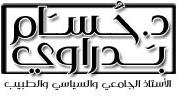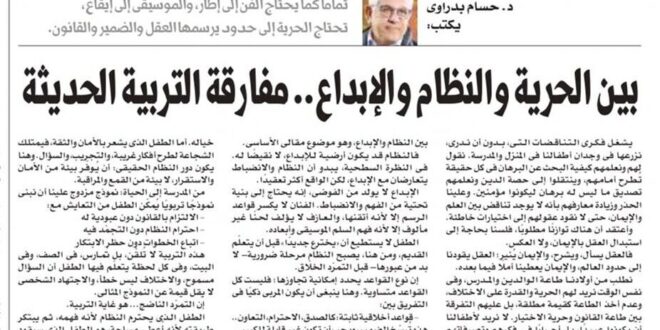Between Freedom, Order, and Creativity: The Paradox of Modern Education
By: Dr. Hossam Badrawi
Do we raise our children on contradictions without realizing it? Do we encourage them to think freely, then reward those who obey without question?
What occupies my mind are the contradictions we unknowingly plant in the hearts of our children at home and in school. We tell them to seek evidence for every truth presented to them, then send them to religion class where we teach them to believe in what has no evidence, as part of their faith. We must be careful and expand their understanding that there is no contradiction between science and faith, so as not to steer their minds toward false choices. I believe a balance is necessary. We don’t need to replace reason with faith, nor the opposite.
Reason questions and explains, while faith enlightens; reason takes us to the limits of the world, and faith gives us hope beyond it.
We ask our children to obey parents, teachers, and leaders, while at the same time we want them to have freedom, the ability to disagree, and not to treat obedience as an absolute value. They should distinguish between obeying the law and having freedom of choice. We don’t want our children to be slaves, but rather free in their thinking and actions, with respect for elders and the more experienced.
Obedience is a psychological act and may be a form of “social influence in which a person yields to explicit instructions or orders from an authority figure.” Obedience is generally different from compliance, which is influenced by peers, and conformity, which aims to match the behavior of the majority. Depending on the context, obedience may be considered moral — as in the structure of armies — or immoral if tied to domination or gaining privileges over others.
Civilization is built by free individuals. Enslavement through obedience — whether political or social — is unacceptable. We should teach our children that compliance with laws agreed upon by society and applied equally to all is what regulates freedom and equality. This should not be considered blind obedience.
We must also think about the contradiction between order and creativity — which is the central topic of my article. At first glance, order and discipline may seem at odds with creativity. But the reality is more complex.
Creativity does not arise from chaos. It needs a foundation of understanding and discipline. An artist breaks the rules of drawing only because they have mastered them. A musician creates an unconventional melody only because they understand the musical scale and its dimensions. A child cannot “invent something new” without first learning the old. In this sense, order is a necessary phase — one that must be passed through — before reaching creative rebellion.
The type of rules determines whether they can be transcended, because not all rules are equal. Educators must be smart enough to distinguish between:
- Fixed moral rules: such as honesty, respect, and cooperation… these instill conscience and must be non-negotiable.
- Procedural or methodological rules: such as how to solve a problem or the format for writing an essay… these should be taught first, then children should be encouraged to reshape them as their thinking matures.
In modern education, we first teach the child a specific method for writing or calculating, then ask: “Can you suggest another way? Do you see anything that could be improved?”
Fear of making mistakes… is the enemy of creativity.
In traditional educational systems, mistakes are met with punishment or reprimand. But in a creative environment, mistakes are the first step toward discovery. That’s why children must be convinced that “making mistakes is part of learning, not a sign of failure.” An inspiring teacher is one who encourages children to try — even if they fail — and celebrates their courage to think, not just the accuracy of their answers.
- Emotional and psychological stability is essential for launching creativity. Creativity isn’t just a cognitive function — it’s also a psychological state. A child who is anxious, afraid, and constantly watched cannot let their imagination soar. But a child who feels safe and confident has the courage to propose strange ideas, experiment, and ask questions. This is the true role of order: to create an environment of safety and stability — not one of oppression and surveillance.
From school to life: a dual model
We must build an educational model that enables children to live with:
- Commitment to the law without being enslaved by it
- Respect for order without becoming rigid
- Following procedures without banning innovation
This kind of education is not taught — it is practiced: in the classroom, at home, and in every moment where the child learns that questioning is allowed, that disagreement is not a mistake, and that personal effort is as valuable as the ideal model.
Advice for educators: how do we balance?
- Start by teaching order well… then allow it to be broken thoughtfully.
- Encourage the child to always ask “Why?”, even for the simplest rules.
- Say: “This is a correct way… but there are other ways too.”
- Turn chaos into a chance for discussion, not punishment.
- Measure progress by the depth of questions, not just the accuracy of answers.
Practical examples in education:
- Ask students to write a short story following a traditional format, then ask them to write another story that breaks the format — for example, starting from the end or using a silent character.
- In one of the public schools I help develop through the Takatof organization, a teacher launched an initiative called “I Disagree… Therefore I Think”, asking students to suggest new ways to solve simple problems, even if they went against the textbook, as long as they were logical.
- At home, when a child asks his mother: “Why do we make our beds every morning?”, her response might be: “No problem if you skip it today, but try to see how you feel in a tidy room, then judge for yourself.”
These small moments are what build a flexible awareness that balances order and freedom.
Mature rebellion… is the goal of education.
The child who respects order because they understand it — and then invents their own way because they were given the space — is the child who will lead the future, not follow it.
Yet freedom is often misunderstood — imagined as total release from every constraint, rebellion against every system, and detachment from all responsibility. But is that what true freedom really is? Or is what we sometimes see — breaking rules and rebelling against values — merely chaos dressed in the clothes of freedom?
Freedom without responsibility turns into chaos.
Freedom unbound by conscience or law creates a disorder that threatens everyone. A person is not truly free when they do whatever they want, but when they are aware of the consequences of their actions, bear responsibility for their decisions, and choose their behavior with moral awareness.
Chaos is not synonymous with freedom — it is its opposite.
In chaos, the strong devour the weak, right is confused with wrong, and the ability to distinguish noble actions from senseless ones disappears. But under true freedom, self-discipline, respect for others, and the pursuit of the common good become essential conditions.
Commitment does not contradict freedom — it protects it from slipping into absurdity.
Just as art needs a frame, and music needs rhythm, freedom needs boundaries set by reason, conscience, and law. When we believe that freedom does not mean chaos, we begin to build wise, strong societies that elevate human dignity and give everyone their rights without infringing on the rights of others.
We are not raising slaves to the system… we are nurturing children who can reshape the world — with ethics, freedom, and imagination.
 Dr. Hossam Badrawi Official Website
Dr. Hossam Badrawi Official Website


